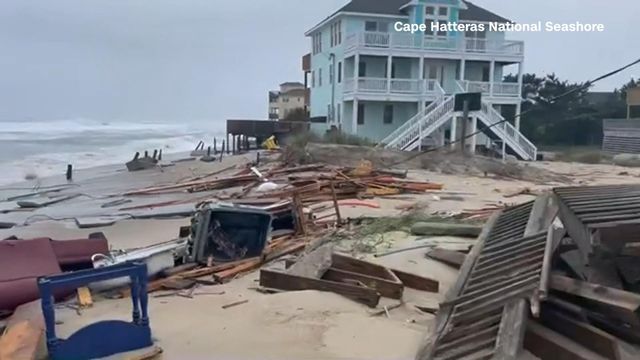Weathering the storm: Homes collapsing on Outer Banks a reminder of NC coast's uncertain future
The state has long championed its coastline for its natural beauty and scenic views, but between factors like rising sea levels, hurricanes and erosion, the environment is a valid concern for people trying to build a life there.
Posted — UpdatedThe state has long championed its coastline for its natural beauty and scenic views, but between factors like rising sea levels, hurricanes and beach erosion, the environment is a valid concern for people trying to build a life there. Waterfront homes and livelihoods are especially vulnerable, as is the area's penchant for attracting tourists.
Dr. Reide Corbett of the Coastal Studies Institute says this kind of erosion is nothing new on the Outer Banks. Beach communities around the world are looking at a future where they'll have to manage the effects of climate change.
"It is happening today," said Corbett. "We see the effects today, we can use that and use the experiences that we have today to try and understand and come up with a plan moving forward to create a more resilient community for us and many communities around the globe."
Corbett says the Outer Banks barrier islands themselves are not fragile, however, the infrastructure we put on them is, forcing residents to adapt. As barrier islands, sand shifts naturally in the Outer Banks, constantly moving the water line and placing homes at risk.
"I think it speaks to the increased vulnerability of the Outer Banks as a barrier island," said Kevin Zorc, who lived on the Outer Banks for 40 years. "You know, the effects of sea level rise and climate change I think are playing out in a real world scenario."
"It’s not just sea level rise, but we’re also dealing with shoreline erosion," Corbett said. "And this is not a new problem along the Outer Banks."
Researchers said at a rate of around four millimeters per year, rising sea levels from climate change are speeding up that process.
“There are many homes that are in harm’s way, or are more vulnerable than some of the other homes,” Dr. Corbett said. “This won’t be the last house that is likely consumed by the Atlantic if something isn’t done by these homeowners or other processes to try and prevent that moving forward.”
The encroaching seas aren’t limited to Ocean Drive, where county leaders told WRAL News that eight of the 11 homes were considered at risk before Tuesday’s collapse.
Meanwhile, NC Highway 12 remains closed between Oregon Inlet and Rodanthe. The only major road connecting the Outer Banks has been shut down by sand and sea for several days due to storms, with crews still working to clear it as of Wednesday afternoon.
Some people living in the Outer Banks told WRAL News they were determined to weather the storm, looking for solutions like elevated bridges to ease access and evacuation routes.
But for others, the impact to businesses, tourism, and even their daily lives has become too much.
“Just talk about town, some people reach their tipping point and they’ve had enough,” Zorc said. “And some have to go, and maybe find some more stable surroundings.”
Ferry service along the Outer Banks still is suspended.
Related Topics
• Credits
Copyright 2024 by Capitol Broadcasting Company. All rights reserved. This material may not be published, broadcast, rewritten or redistributed.






